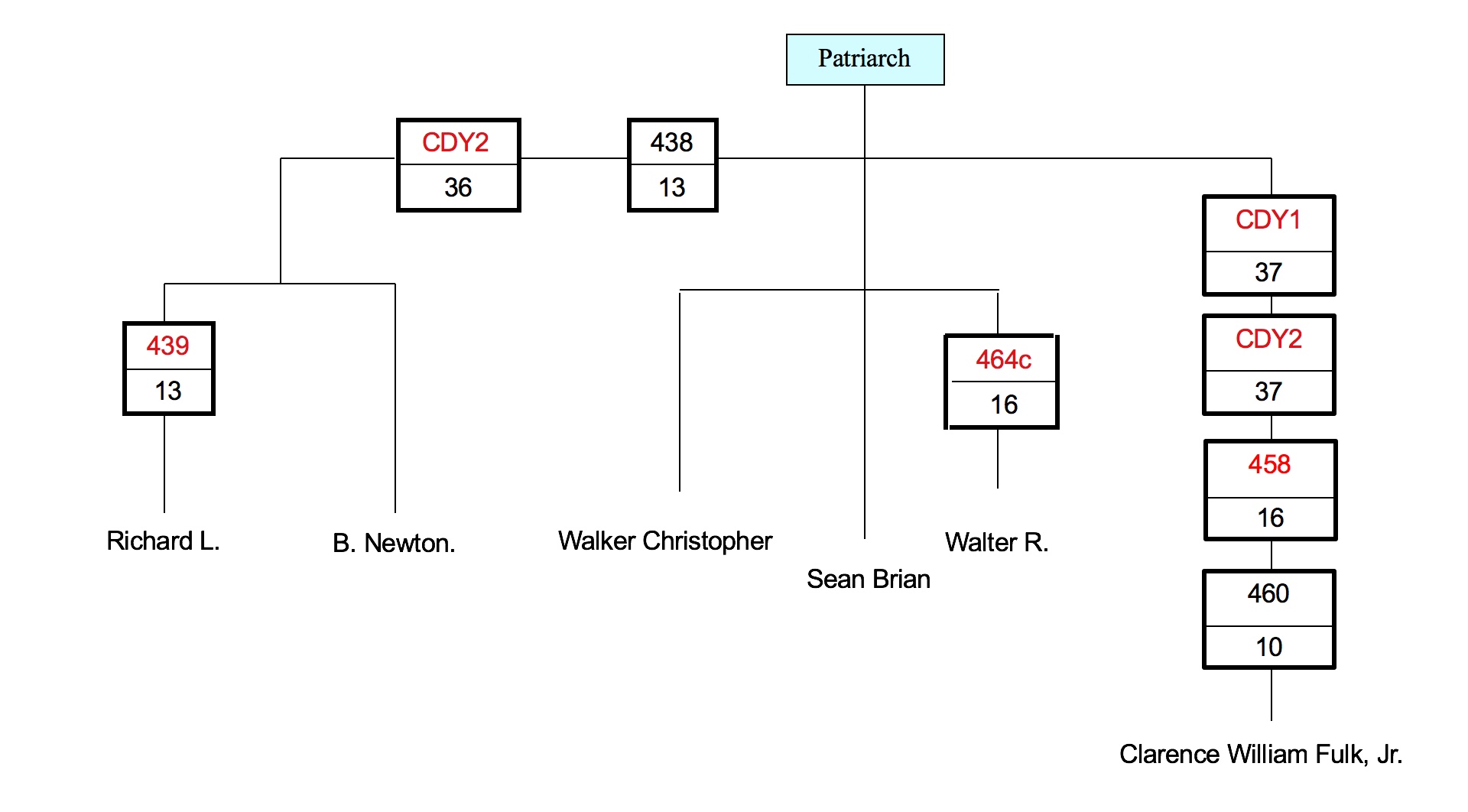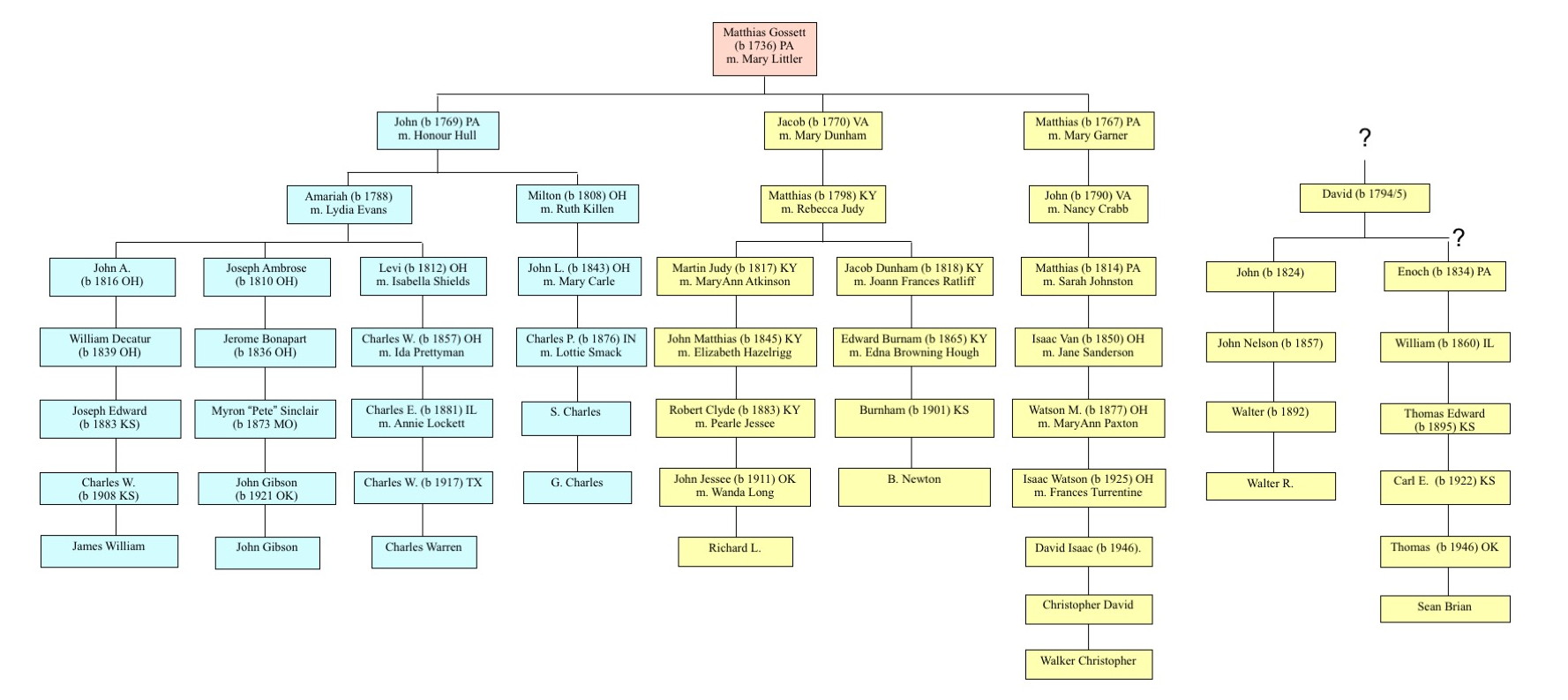Results From YDNA-Based Analysis
The Group-II Conundrum
Introduction
The “conundrum” in the title of this section refers to the situation where we have project participants who, based on “traditional” Gossett genealogy (i.e., Newcomer’s book) all claim descent from Matthias Gossett (b 1736; m Mary Littler). However, their descents are through three different, alleged sons of Matthias, and these project participants genetically fall into two distinctly different Groups (I and II), based on YDNA – groups dissimilar enough that there is only a 5% chance that they share a MRCA in the most recent 700 years. They clearly cannot all descend from this Matthias.
Group II
The project thus far has five, Gossett-surnamed participants (Richard L., B. Newton, Walker Christopher, Walter R., and Sean Brian) who have been categorized as "Group II" on the basis of YDNA markers. Additionally, we have one, Fulk-surnamed participant (Clarence William Fulk, Jr.) whom we have placed in Group II, based upon YDNA marker similarities. The similarity is evident if one looks at the 50% probability table. There is a 50% probabability that Clarence William Fulk, Jr., and SeanBrian/WalkerChrisopher share a MRCA within the most recent 330 years.
With so few Group IIs in our project, it might seem a bit premature to present a YDNA-marker-based tree, nonetheless we've done so:

Shown on the tree are points where markers have changed, relative to those of the Patriarch (their MRCA, whose marker values are presumed to be the modal values of our six participants). Walker Christopher and Sean Brian are shown on different branches, though their markers are identical, because we know from their paper trails that their lineages diverge more than a few generations ago.
The paper-trails of the five, Group-II, Gossett-surnamed participants are shown in the chart below in yellow. The paper-trails of Richard L., B. Newton, and Walker Christopher convincingly show descent from Matthias Gossett (b 1736, PA; m. Mary Littler). Sean Brian's paper-trail goes back with strong supporting evidence as far as Enoch (b 1834, PA). Walter R. descends with near certainty from David (b 1794/5) through one of David's sons, John. Researcher Linda Harden-Lantz has presented us with good circumstantial evidence that Sean's ancestor Enoch was another of David's sons. We have shown their lineages that way in the chart below, but the assertion is based mostly on Enoch's having a birth date consistent with his being a son of David, as well as Enoch's residence in the same area of southwestern Pennsylvania at the same time. If Enoch was not a son of David, their relationship was likely a close one (e.g., uncle-nephew). Thus far we have found no direct evidence of their father-son relationship, but it's reasonable to believe it to be so.
There is, as yet, no known path that connects David (b 1794/5 PA) to Matthias (b 1736 PA). That all are Group II certainly means they are closely related, but the MRCA of all could be back a few generations before Matthias (b 1736 PA). There is an intriguing, apparent socio-economic and educational gulf between the known sons and grandsons of Matthias (b 1736), versus those of David (b 1794/5). The former were landowners and possibly clerics or rectors; the latter were mostly illiterate coal miners.
Group I
The "Conundrum" in the title of this page refers -- not to what we've written in the preceding paragraphs -- but rather to the following: We have four other participants (James William, John Gibson, Charles Warren, and G. Charles) who -- on the basis of "traditional" Gossett genealogy -- also appear to trace back to Matthias (b 1736, PA), but whose YDNA markers clearly put them into Group I. The conundrum is depicted below:
Cick on here to view chart in larger size.
The claimed lineages of the four Group-I participants are coded in blue; those of the five Group-II, Gossett-surnamed participants, in yellow. The YDNA results of James William, John Gibson, Charles Warren, and G. Charles suggest close relationship to one another. The YDNA results of Richard L., B. Newton, Walker Christopher, Walter R., and Sean Brian similarly show close relationship among the five. However, there is only a 5% chance of a shared ancestor between the "blues" and the "yellows" within the past 700 years. Clearly both groups cannot be biologically descendants of Matthias (b 1736).
Additionally, we note that, while few of our participants have had deep-clade haplogroup analysis, Sean Brian has. While he is in the same, over-arching, R-M269, haplogroup shared by all Group-I and Group-II Gossetts, deep-clade analysis places him in subgroup R-U152 -- following a different branch-point from P312 within R-M269 than Group I's Charles Warren and James Michael, who both follow a branch passing through DF27.
Origins of Group II
Could the results be explained by the occurrence of an Unknown Paternity Event (UPE) [also commonly known as a "Non-Paternity Event, NPE," a term we don't prefer because there is no such thing as "non-paternity;" every child has a father, it's merely that we do not always know who he was]? A UPE is one where, in this case, the Gossett YDNA link from father, to son, to grandson, etc., is broken by a non-Gossett male's YDNA entering the lineage. It need not have resulted from anything scandalous (e.g., extramarital affair). For example, a Gossett male could have married a widow with young son from her previous marriage. The new Gossett husband could simply have adopted the child -- formally or informally. Another example: a Gossett family might have adopted an orphaned son on the wife's side of the family; this son would carry the Gossett surname thereafter, but not the Gossett YDNA.
If a UPE is invoked as possible explanation for the situation depicted above, it would likely have had to occur on the "yellow" side, because the "blue" side participants have Group-I YDNA -- the most prevalent pattern found thus far among American Gossetts. On the other hand, if a paper-trail descent from Matthias is accepted for all nine project participants, a UPE is unlikely to explain the YDNA variant occurring among "yellow" side participants because the markers are shared by at least two different sons of Matthias (b 1736) -- Jacob (b 1770) and Matthias (b 1767). Both Jacob and Matthias, Jr., would have to have been adopted or sired out of wedlock by the same male, and that seems improbable, although not impossible. It's also hard to explain the diverse lineages among our Group IIs. Their MRCA is likely someone well before Matthias (b 1736), given the aforementioned socio-economic and educational differences between David (b 1794/5) and the known, Group-II grandsons of Matthias (b 1736).
The addition of a Fulk-surnamed participant to Group II is an intriguing development. Clarence's closest matches at Y37 are as follows (all 1-marker different): James Foulk (descendant of Andreas Volck b. 1678); Raymond Mitchell Foulk III (descendant of George W. Foulk b. 1774); Daniel R. Fulk (descendant of Jacob Volck, b. <1660). Unfortunately, none of these has been tested beyond Y37. The number of them -- all possessing surnames and antecedent surnames that are homophonic (Fulk, Foulk, Volck) suggests that Clarence's distant male ancestors were surnamed Fulk, Foulk, or Volck. Thus, the possibility is presented that Group-II Gossetts derive (possibly via UPE) from Fulk, Foulk, or Volck ancestors. The UPE could have occurred in America, or back in Europe. Clarence's paper trail identifies his most distant, traced ancestor to be John Fulk, who was born ca. 1740 and whose family migrated from PA to Rockingham Co., VA. Less certain is that John Fulk's father was a Mathew Fulk (b c1713) who was in Massanutten, Rockingham Co, VA in the 1720s or 1730s.
A More Likely Explanation: A Case of Mistaken Identity
A more likely explanation is that the "blue" side participants do not descend from Matthias (b 1736), and that Matthias (b 1736) descends from a different Gossett immigrant than do the Group-I participants.
Our reason for suggesting that James William, John Gibson, Charles Warren, and G. Charles do not descend from Matthias (b 1736) is because what we have termed “traditional” Gossett genealogy, is almost exclusively based on Evangeline Gossett Newcomer’s book, The Family of Gossett. The documentary evidence for descent of John (b 1769) – the MRCA of the “blue” side – from Matthias (b 1736) is, frankly, nonexistent. Matthais’ son John was born before 1758 (based on a 1758 Loudon County lease indenture that mentions him). This is explored more fully here in genealogical research reported by Eric Talla and Judith Gossett Talla, and here in research reported by James William Gossett concerning John Gossett of Ohio (b 1769). The latter provides a particularly compelling case for John (b 1769) not being the son of Matthias (b 1736).
There were several "John" and "Matthias" Gossetts in the same general area and time-period. And based on YDNA analysis and research reported here on this site, we strongly believe that John (b 1769) is probably the grandson of “John of PA,” the oldest son of John Gossett and Jane Williamson/Willemsen of New Castle. This is as shown in the middle portion of the Group-I tree here.
Return to Homepage  Previous Page Next: Research on Matthias Gossett (b 1736)
Previous Page Next: Research on Matthias Gossett (b 1736) 
